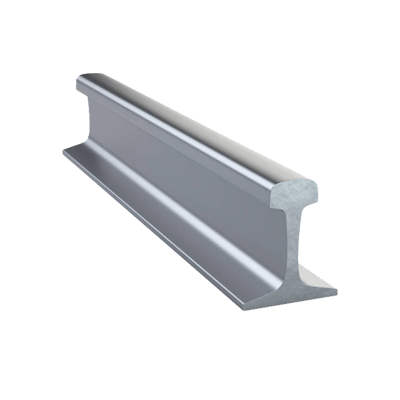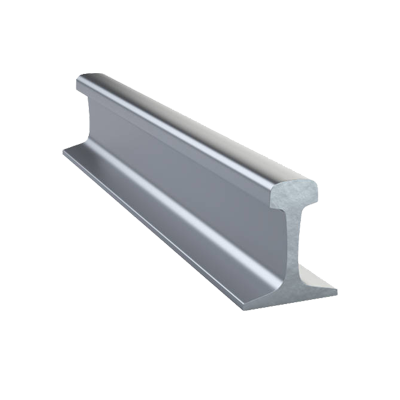Call +(254) 703 030 000 / 751 483 999 / 721 704 777
- Home
- Steel
- Carbon Steel Long Products
- Rails Hot Rolled High Carbon Low Alloy
.....Read More
Frequently Asked Questions
What are the benefits of using high-carbon, low-alloy hot-rolled steel rails in railway infrastructure?
High-carbon, low-alloy hot-rolled steel rails offer several benefits for railway infrastructure:
1. **Enhanced Strength and Durability**: The high carbon content increases the hardness and tensile strength of the steel, making it more resistant to wear and deformation. This is crucial for withstanding the heavy loads and high-speed stresses experienced in railway operations.
2. **Improved Wear Resistance**: The alloying elements, such as manganese, chromium, and vanadium, enhance the steel's wear resistance. This reduces the frequency of rail replacements and maintenance, leading to lower operational costs and less downtime.
3. **Better Fatigue Resistance**: The combination of high carbon and alloying elements improves the fatigue resistance of the rails. This is essential for enduring the cyclic loading and unloading that occurs as trains pass over the tracks, thereby extending the rail's service life.
4. **Cost-Effectiveness**: Although the initial cost of high-carbon, low-alloy steel may be higher than standard steel, the extended lifespan and reduced maintenance needs make it a cost-effective choice in the long run.
5. **Enhanced Performance in Extreme Conditions**: These rails perform well in extreme weather conditions, maintaining their structural integrity in both high and low temperatures. This is particularly beneficial in regions with harsh climates.
6. **Reduced Risk of Rail Breakage**: The improved mechanical properties reduce the likelihood of rail breakage, enhancing safety and reliability in railway operations.
7. **Sustainability**: Longer-lasting rails mean fewer replacements, which can contribute to sustainability efforts by reducing the environmental impact associated with manufacturing and transporting new rails.
Overall, high-carbon, low-alloy hot-rolled steel rails provide a robust, reliable, and economically advantageous solution for modern railway infrastructure.
How does the hot-rolling process work for manufacturing steel rails?
The hot-rolling process for manufacturing steel rails involves several key steps. Initially, raw steel is melted in a furnace and cast into large rectangular blocks called blooms. These blooms are then heated to a high temperature, typically around 1,200°C (2,192°F), to make the steel malleable.
Once heated, the blooms are passed through a series of rolling mills. These mills consist of large, heavy rollers that compress and elongate the steel, reducing its cross-sectional area and shaping it into a long, continuous rail. The rolling process is done in multiple stages, with each stage progressively refining the shape and dimensions of the rail.
During rolling, the steel is kept at a high temperature to maintain its ductility and prevent cracking. The rollers are precisely calibrated to ensure the rail meets specific dimensional and surface quality standards. As the steel passes through the rollers, it is also subjected to controlled cooling, which helps in achieving the desired mechanical properties and microstructure.
After rolling, the rails are straightened and cut to the required lengths. They undergo further quality checks, including dimensional inspections and ultrasonic testing, to detect any internal defects. The final step involves hardening the railhead through a process called head hardening, which enhances wear resistance and extends the rail's service life.
The entire hot-rolling process is designed to produce steel rails with the necessary strength, durability, and precision required for railway applications.
Why is high carbon content important in steel rails?
High carbon content is crucial in steel rails because it significantly enhances their hardness and strength, which are essential for withstanding the heavy loads and high stress experienced during train operations. Carbon acts as a hardening agent, allowing the steel to resist deformation and wear over time. This is particularly important for rails, which are subject to constant friction and impact from train wheels.
The increased hardness from higher carbon content also improves the wear resistance of the rails, reducing the frequency of maintenance and replacement. This is economically beneficial and ensures the safety and reliability of rail transport systems. Additionally, high carbon steel can better absorb and distribute the energy from the dynamic forces exerted by moving trains, minimizing the risk of rail deformation or failure.
However, it's important to balance carbon content, as excessively high levels can make the steel brittle, leading to potential cracking under stress. Therefore, the carbon content in rail steel is carefully controlled to optimize the balance between hardness, strength, and ductility, ensuring the rails can endure the operational demands while maintaining structural integrity.
What role do low-alloy compositions play in the performance of steel rails?
Low-alloy compositions in steel rails enhance performance by improving mechanical properties and extending service life. These compositions typically include small amounts of elements like manganese, chromium, vanadium, and molybdenum, which contribute to the following benefits:
1. **Increased Strength and Hardness**: Alloying elements refine the grain structure of steel, leading to increased tensile strength and hardness. This is crucial for rails, which must withstand heavy loads and resist deformation.
2. **Improved Wear Resistance**: Elements like chromium and vanadium form hard carbides that enhance wear resistance. This is vital for reducing rail degradation due to friction and contact with train wheels.
3. **Enhanced Toughness**: Low-alloy steels maintain toughness at lower temperatures, reducing the risk of brittle fracture. This is important for rails exposed to varying environmental conditions.
4. **Better Fatigue Resistance**: Alloying elements improve fatigue resistance by reducing the initiation and propagation of cracks. This extends the rail's lifespan under cyclic loading conditions.
5. **Corrosion Resistance**: Elements such as chromium provide a degree of corrosion resistance, protecting rails from environmental factors like moisture and chemicals.
6. **Cost-Effectiveness**: Low-alloy steels offer a balance between performance and cost, providing enhanced properties without the expense of high-alloy or specialty steels.
Overall, low-alloy compositions optimize the performance of steel rails by enhancing their mechanical properties, durability, and resistance to environmental and operational stresses, ensuring safe and efficient railway operations.
How do high-carbon, low-alloy steel rails contribute to reduced maintenance costs?
High-carbon, low-alloy (HCLA) steel rails contribute to reduced maintenance costs primarily through their enhanced mechanical properties and durability. These rails are engineered to possess a higher carbon content and specific alloying elements, such as manganese, chromium, and vanadium, which significantly improve their hardness and wear resistance.
The increased hardness of HCLA steel rails results in a higher resistance to wear and deformation under the heavy loads and high-speed conditions typical in railway operations. This means that the rails maintain their shape and surface integrity for longer periods, reducing the frequency of rail grinding and replacement. Consequently, the need for labor-intensive and costly maintenance activities is minimized.
Additionally, the alloying elements in HCLA steel enhance its toughness and fatigue resistance. This reduces the likelihood of rail defects such as cracks and fractures, which are common causes of rail failures. By minimizing these defects, the rails contribute to a safer and more reliable railway system, further decreasing the need for emergency repairs and associated downtime.
Moreover, the improved durability of HCLA steel rails extends their service life, leading to a lower total cost of ownership. The initial investment in these higher-quality rails is offset by the savings in maintenance and replacement costs over time.
In summary, high-carbon, low-alloy steel rails reduce maintenance costs by offering superior wear resistance, toughness, and longevity, which collectively decrease the frequency and extent of maintenance interventions required to keep railway systems operational and safe.
What are the advantages of using these steel rails for high-speed trains?
Steel rails offer several advantages for high-speed trains:
1. **Strength and Durability**: Steel is incredibly strong and can withstand the high forces exerted by high-speed trains. This durability ensures a long lifespan for the rails, reducing the need for frequent replacements and maintenance.
2. **Smoothness**: Steel rails provide a smooth and continuous surface, minimizing friction and allowing trains to travel at higher speeds with greater efficiency. This smoothness also reduces wear and tear on train wheels.
3. **Load-Bearing Capacity**: Steel rails can support the heavy loads of high-speed trains, ensuring stability and safety. This capacity is crucial for maintaining the structural integrity of the rail system under the dynamic loads of fast-moving trains.
4. **Thermal Expansion**: Steel has predictable thermal expansion properties, which can be managed with expansion joints and other engineering solutions. This predictability is essential for maintaining track alignment and safety in varying temperatures.
5. **Conductivity**: Steel is a good conductor of electricity, which is beneficial for electric trains that use the rails as part of their electrical circuit. This conductivity supports efficient power distribution and signaling systems.
6. **Recyclability**: Steel is highly recyclable, making it an environmentally friendly option. Old rails can be melted down and reused, reducing the environmental impact of rail production and maintenance.
7. **Cost-Effectiveness**: While the initial cost of steel rails can be high, their longevity and low maintenance requirements make them cost-effective over time. The reduced need for repairs and replacements translates to lower operational costs.
8. **Safety**: Steel rails provide a stable and reliable track for high-speed trains, reducing the risk of derailments and accidents. Their strength and resilience contribute to the overall safety of the rail system.
These advantages make steel rails an ideal choice for high-speed train infrastructure, supporting efficient, safe, and sustainable rail transport.
How does the durability of high-carbon, low-alloy steel rails compare to other types of rails?
High-carbon, low-alloy (HC-LA) steel rails are known for their enhanced durability compared to other types of rail materials. The increased carbon content in these rails contributes to higher hardness and strength, which improves wear resistance. This makes HC-LA steel rails particularly suitable for heavy-duty applications, such as freight and high-speed railways, where the rails are subjected to significant mechanical stress and wear.
Compared to standard carbon steel rails, HC-LA steel rails exhibit superior resistance to deformation and fatigue, which extends their service life. The addition of alloying elements like manganese, chromium, and vanadium in HC-LA steels further enhances their mechanical properties by refining the grain structure and improving toughness. This results in better performance under cyclic loading conditions, reducing the risk of rail defects such as cracking and spalling.
In contrast, rails made from lower carbon steels or those without alloying elements may wear out more quickly under similar conditions, requiring more frequent maintenance and replacement. While stainless steel rails offer excellent corrosion resistance, they are generally more expensive and may not provide the same level of hardness and wear resistance as HC-LA steel rails.
Overall, the durability of HC-LA steel rails makes them a cost-effective choice for railways that prioritize long-term performance and reduced maintenance costs. However, the specific choice of rail material may also depend on other factors such as environmental conditions, budget constraints, and specific operational requirements.


